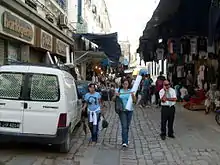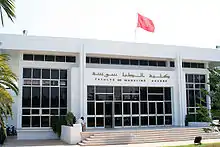Languages of Tunisia
Tunisia is a multilingual country.[1] The original language of Tunisia since ancient times is the Berber language, but most Tunisians slowly switched to a variety of Arabic, over 13 centuries of Arabization and Islamization.
| Languages of Tunisia | |
|---|---|
| Official | Arabic |
| National | Tunisian Arabic (de facto) |
| Minority | Berber languages |
| Foreign | French, English |
| Signed | Tunisian Sign Language |


The vast majority of the population today speaks Tunisian Arabic (also called Derja) as their native language, which is mutually intelligible to a limited degree with other Maghrebi Arabic dialects. Most inhabitants are also literate in Modern Standard Arabic (i.e. Literary Arabic) taught in primary and secondary education. A significant portion of the population also can speak some French to varying degrees which was the common language of business and administration during French rule in the region.
The Berber language is still spoken today by thousands of Tunisians who did not undergo full arabization.
Tunisian Arabic
The Tunisian Derja (تونسي) is considered a variety of Arabic – or more accurately a set of dialects.[2]
Tunisian is built upon a significant Berber, African Romance[3][4] and Neo-Punic[5][6] substratum, while its vocabulary is mostly derived from a morphological corruption of Arabic, French, and English.[7] Multilingualism within Tunisia and in the Tunisian diaspora makes it common for Tunisians to code-switch, mixing Tunisian with French, English or other languages in daily speech.[8]
Moreover, Tunisian is closely related to the Maltese language,[9] that descended from Tunisian and Siculo-Arabic.[10][11]
Berber languages
Berber languages (called "shelha" by Arabic-speakers) are mainly spoken in the villages of the south, including Chenini, Douiret, Matmata and Tamezrett. They are also spoken in some hamlets on the island of Djerba, mainly Guellala, Iquallalen, Ajim, Sedouikech, Azdyuch and Ouirsighen.
French
During the French colonization of Tunisia, French was introduced in public institutions, most notably the education system, which became a strong vehicle for dissemination of the language. From independence, the country gradually became arabized even though the public administration and education remained bilingual.[12] Meanwhile, knowledge of French and other European languages (such as English) is enhanced by Tunisia's proximity to Europe and by media and tourism.
The 1990s marked a turning point for the Arabization process. Science classes up to the end of middle school were Arabized in order to facilitate access to higher education and promote the Arabic language in society.[12] Since October 1999, private establishments have been obliged to give Arabic characters twice the size of Latin characters.[12] This rule is not always followed, however. At the same time, the public administration is required to communicate in Arabic only. In this context, the use of French seems to be in decline despite the increased number of graduates in the educational system, which leads to the fact that a good knowledge of French remains an important social marker.[12] This is because French is widely used in the business community, intellectual domains and the spheres of natural science and medicine. Because of this, one can consider the language to have become gentrified.[12] Thus, French in Tunisia is a prestige language.[13]
According to recent estimates provided by the Tunisian government to the Organisation Internationale de la Francophonie, the number of French speakers in the country is estimated at 6.36 million people, or 63.6% of the population.[14]
See also
- Demographics of Tunisia
- Arab world
- Arabized Berber
- French language in the Maghreb
- Languages of Algeria
- Languages of Morocco
References
- (in French) Aménagement linguistique en Tunisie (Université de Laval) Archived 2009-06-02 at the Wayback Machine
- « Travaux de phonologie. Parlers de Djemmal, Gabès, Mahdia (Tunisie) et Tréviso (Italie) », Cahiers du CERES, Tunis, 1969
- (in French) Tilmatine Mohand, Substrat et convergences: Le berbére et l'arabe nord-africain (1999), in Estudios de dialectologia norteafricana y andalusi 4, pp 99–119
- (in Spanish) Corriente, F. (1992). Árabe andalusí y lenguas romances. Fundación MAPFRE.
- Elimam, Abdou (1998). ' 'Le maghribi, langue trois fois millénaire. ELIMAM, Abdou (Éd. ANEP, Algiers 1997), Insaniyat. pp. 129–130.
- A. Leddy-Cecere, Thomas (2010). Contact, Restructuring, and Decreolization:The Case of Tunisian Arabic (PDF). Linguistic Data Consortium, Department of Asian and Middle Eastern Languages and Literatures. pp. 10–12–50–77.
- Zribi, I., Boujelbane, R., Masmoudi, A., Ellouze, M., Belguith, L., & Habash, N. (2014). A Conventional Orthography for Tunisian Arabic. In Proceedings of the Language Resources and Evaluation Conference (LREC), Reykjavik, Iceland.
- Daoud, Mohamed (2001). "The Language Situation in Tunisia". Current Issues in Language Planning. 2: 1–52. doi:10.1080/14664200108668018.
- Borg and Azzopardi-Alexander Maltese (1997:xiii) "The immediate source for the Arabic vernacular spoken in Malta was Muslim Sicily, but its ultimate origin appears to have been Tunisia. In fact, Maltese displays some areal traits typical of Maghrebi Arabic although during the past 800 years of independent evolution it has drifted apart from Tunisian Arabic".
- Borg, Albert J.; Azzopardi-Alexander, Marie (1997). Maltese. Routledge. ISBN 0-415-02243-6.
- "The Language in Tunisia, Tunisia | TourismTunisia.com". www.tourismtunisia.com. Retrieved 2017-07-31.
- Samy Ghorbal, «Le français a-t-il encore un avenir ? », Jeune Afrique, 27 avril 2008, pp. 77-78
- Stevens, Paul (1980). "Modernism and Authenticity as Reflected in Language Attitudes : The Case of Tunisia". 30, no. 1/2. Civilisations. pp. 37–59.
- "Christian Valantin (sous la dir. de), La Francophonie dans le monde. 2006-2007, éd. Nathan, Paris, 2007, p. 16" (PDF) (in French). Archived from the original (PDF) on 2012-10-16. Retrieved 2011-03-05. (5.58 MB)
Further reading
- Gabsi, Zouhir. "Attrition and maintenance of the Berber language in Tunisia." International Journal of the Sociology of Language, September 2011. Issue 211, p. 135. ISSN 0165-2516. Available on Academic OneFile.
- Stevens, P. (1983). "Ambivalence, Modernisation and Language Attitudes: French and Arabic in Tunisia." Journal of Multilingual and Multicultural Development. Volume 4, Nos. 2 and 3, p. 101-14.